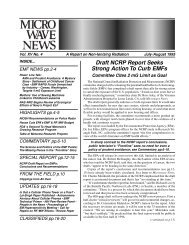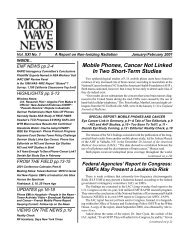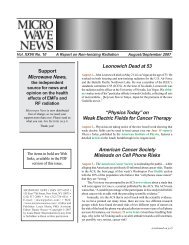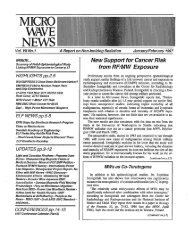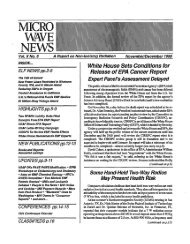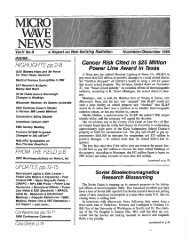You also want an ePaper? Increase the reach of your titles
YUMPU automatically turns print PDFs into web optimized ePapers that Google loves.
RF/MW Safety Standards and the New Telecom Law<br />
the director of ORIA. Sources told <strong>Microwave</strong> <strong>News</strong> that the<br />
EEA’s intense—and sometimes heavy-handed—lobbying<br />
deterred the EPA from proposing its own RF/MW guidelines.<br />
AT&T Bell Labs, the CTIA, the NAB and Raytheon are all<br />
members of the EEA.<br />
The FCC has not indicated what direction it will take, but<br />
Commentary: ANSI/IEEE v. NCRP (continued from p.1)<br />
decisions. Dr. Mays Swicord, formerly with the FDA and now<br />
at Motorola, was so incensed that he threatened to stop at a<br />
local bar on his way to the next subcommittee meeting to pick<br />
up a few sots to vote his way.<br />
“I am not happy with the process,” complained Dr. Elliot<br />
Postow sometime later. Postow, a former Navy man now with<br />
the National Institutes of Health, had identified 17 of the 31<br />
members of the IEEE committee as being associated with the<br />
Department of Defense (DOD). Even Dr. Om Gandhi of the<br />
University of Utah in Salt Lake City, the cochair of the subcommittee<br />
that wrote the standard, warned that this “is not<br />
going to sit well with the public.” 2 An investigation was promised<br />
but was soon abandoned.<br />
Similar complaints had been lodged years earlier. In 1984,<br />
Dr. Nicholas Steneck, a professor of history at the University<br />
of Michigan and the author of a book on how the ANSI RF/<br />
MW radiation standards were set, put the ANSI leadership on<br />
notice: “It is irresponsible and possibly immoral to continue<br />
with the status quo,” he wrote. 3<br />
Not long afterwards, EPA’s Dr. Carl Blackman and a number<br />
of others became so concerned over what they perceived<br />
as improprieties in the subcommittee’s work—for instance,<br />
deciding on proposed limits before the scientific data had been<br />
reviewed—that they refused to vote, stalling progress on the<br />
standard. 4 The impasse was finally cleared when the IEEE<br />
stepped in and indemnified all those working on the standard<br />
against future liability.<br />
Any suggestion that the ANSI exposure standard was based<br />
on the best available science is insupportable. Take, for example,<br />
the decision to double the high frequency limit to 10 mW/cm 2 —<br />
one of the EPA’s principal objections against the ANSI standard.<br />
The move to abandon the NCRP limit of 5 mW/cm 2 above<br />
3 GHz was proposed as early as 1986, the year the NCRP guidelines<br />
were released. It was as contentious then as it is today.<br />
This proposal was not driven by any sudden breakthroughs.<br />
The only rationale was to make the RF/MW limit consistent<br />
with a laser standard above 300 GHz 5 —a strange argument<br />
which prompts people to scratch their heads and ask why a<br />
standard should be changed below 3 GHz to meet an unrelated<br />
standard in a different part of the spectrum. In 1989, it<br />
was still a sore point. If the limit were doubled, “We would look<br />
like yo-yos,” cautioned Dr. Quirino Balzano of Motorola. 6<br />
But those in control had already made up their minds in favor<br />
of the 10 mW/cm 2 limit.<br />
Or consider the cancer question. The ANSI/IEEE document<br />
is totally silent about it. Indeed, there is no indication that<br />
the IEEE ever discussed it—an inexplicable lapse, since Dr.<br />
Bill Guy, one of the architects of the standard, ran a $5 mil-<br />
12<br />
has previously maintained that it will defer to government health<br />
agencies in its decision.<br />
On March 26, however, at the CTIA convention in Dallas,<br />
FCC Commissioner Rachelle Chong, who will have a say<br />
in the final decision, told attendees that she is “comfortable”<br />
with the ANSI standard.<br />
lion animal exposure study at 2450 MHz that many observers<br />
are convinced showed a cancer risk. 7<br />
The NCRP committee, under the chairmanship of Guy himself,<br />
had essentially completed its report when his cancer results<br />
emerged. But the council realized that it could not release<br />
the report without addressing the Guy study. In contrast, the<br />
IEEE committee, with Guy as its vice chairman and years to<br />
grapple with the data, simply ignored the issue.<br />
Nor is cancer the only omission. The IEEE committee paid<br />
little, if any, attention to experiments showing effects on the<br />
eye, on the blood-brain barrier and on the nervous system—<br />
all at specific absorption rates well below the ANSI and NCRP<br />
threshold for ill effects of 4 W/Kg.<br />
The EPA and NIOSH, two health agencies that have studied<br />
the RF/MW health data for decades, have each advocated<br />
pegging the threshold to 1 W/Kg for the public and to 2 W/<br />
Kg for workers, respectively.<br />
Ironically, whether the FCC elects to follow ANSI or the<br />
NCRP will not make any difference in the siting of cellular phone<br />
towers—the principal reason for the congressional mandate<br />
to set standards. Nor will it make much difference to the broadcasters.<br />
So why are the CTIA and the NAB fighting so hard<br />
to promote the IEEE and ANSI at the expense of the NCRP?<br />
And why are so many engineers and physicists lobbying against<br />
a standard that they helped write and are now in the process<br />
of revising?<br />
The answer is that if the FCC favors the NCRP guidelines,<br />
it will diminish the influence of the IEEE’s SCC28 committee,<br />
which industry and the military effectively dominate. AT&T,<br />
the CTIA, Raytheon and the DOD know a good thing when<br />
they have it and are fighting to retain control.<br />
The NCRP is a conservative organization, but since it is a<br />
congressionally chartered body there is a degree of public oversight.<br />
It was this measure of accountability that forced a discussion<br />
of the Guy cancer results in 1986.<br />
This also helps explain why so many people involved in<br />
writing the NCRP standard are now attacking it. They are comfortable<br />
working hand in glove with the military and with industry.<br />
But they are uncomfortable with public accountability,<br />
even in very small doses.<br />
The FCC is supposed to base its decisions on the public<br />
interest. It has long maintained that it would defer to the federal<br />
health agencies on RF/MW standards. If so, it has no choice<br />
but to listen to the EPA and favor the NCRP guidelines.<br />
1. See <strong>MWN</strong>, S/O89. 5. See <strong>MWN</strong>, J/A86.<br />
2. See <strong>MWN</strong>, J/A90. 6. See <strong>MWN</strong>, S/O89.<br />
3. See <strong>MWN</strong>, O84. 7. See <strong>MWN</strong>, J/A84, Mr85<br />
4. See <strong>MWN</strong>, J/A86. and N/D86.<br />
MICROWAVE NEWS March/April 1996



